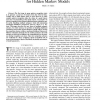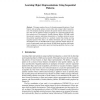475 search results - page 29 / 95 » Pattern Generation with Multiple Robots |
TASLP
2002
13 years 9 months ago
2002
The first stage in many pattern recognition tasks is to generate a good set of features from the observed data. Usually, only a single feature space is used. However, in some compl...
AUSAI
2008
Springer
14 years 2 days ago
2008
Springer
This paper explores the use of alternating sequential patterns of local features and saccading actions to learn robust and compact object representations. The temporal encoding rep...
GECCO
2003
Springer
14 years 3 months ago
2003
Springer
One advantage of evolutionary multiobjective optimization (EMO) algorithms over classical approaches is that many non-dominated solutions can be simultaneously obtained by their si...
TCAD
2010
13 years 4 months ago
2010
Crosstalk faults have emerged as a significant mechanism for circuit failure. Long signal nets are of particular concern because they tend to have a higher coupling capacitance to...
ICONIP
2007
13 years 11 months ago
2007
We propose a technique to make a robot execute free and solitary dance movements on music, in a manner which simulates the dynamic alternations between synchronisation and autonomy...


